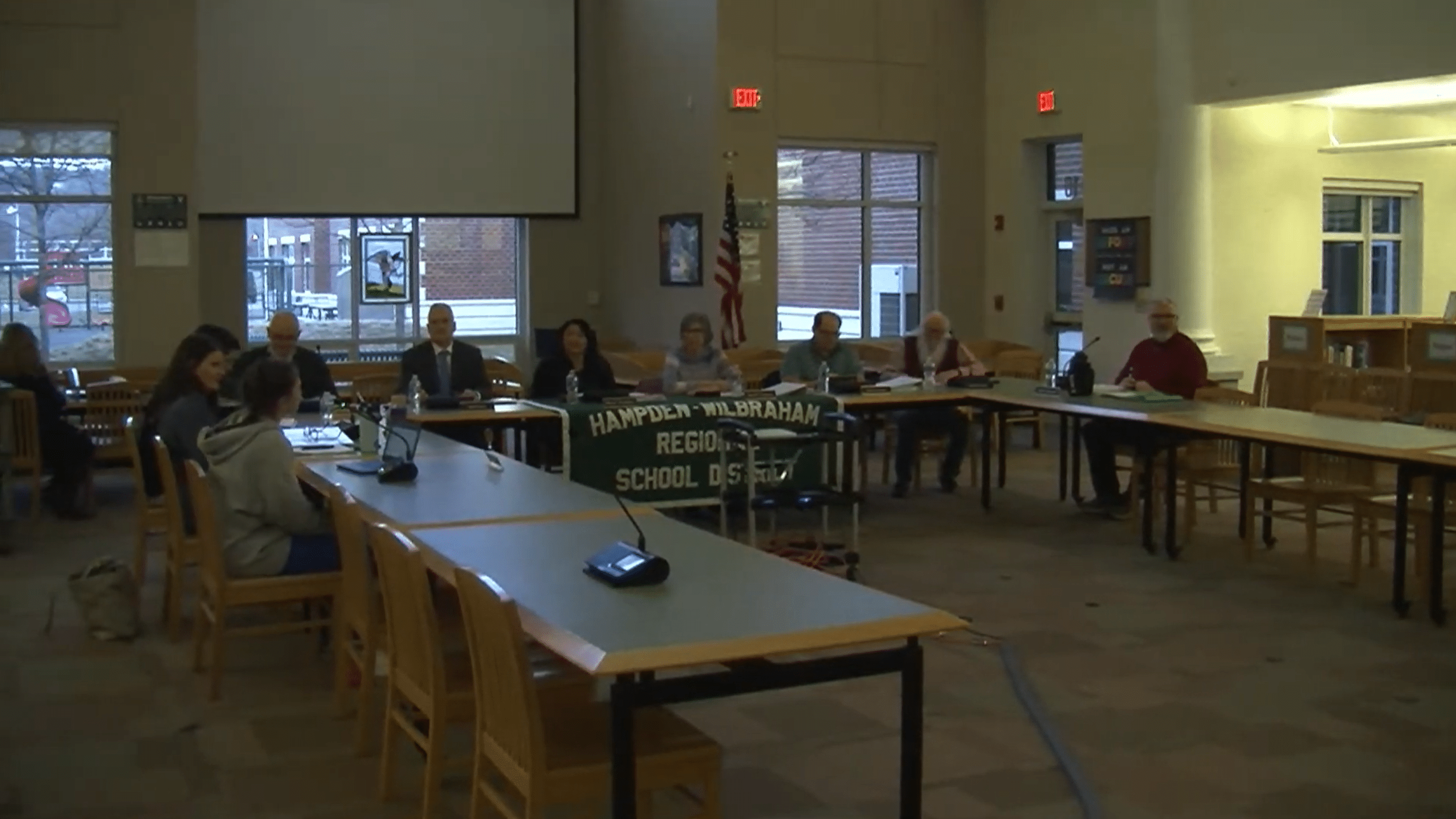The Hampden-Wilbraham Regional School District discussed adjusting town assessments at its March 20 meeting.
Photo credit: Erin Dowding/HWRSD
WILBRAHAM — The Hampden-Wilbraham Regional School District sent fiscal year 2026 assessment letters to both towns ahead of their spring town meetings, when the budget will be up for a vote. In a budget season full of tough decisions, however, the School Committee still questioned whether to adjust the assessments in hopes of earning good will and avoiding an us-versus-them funding situation.
The School Committee approved the $41.46 million level service budget on March 6. After funding offsets to the district’s operating budget are deducted, the towns must vote on whether to pay for the remaining costs and assessments are split to reflect enrollment. Therefore, Wilbraham’s portion would be $32.09 million, $1.85 more than FY25. Hampden would be responsible for $9.37 million, $557,770 over this year’s assessment.
School Committee member Sean Kennedy said the Wilbraham Finance Committee was hoping that the $25,000 saved through athletic fee increases would be taken off the assessments. He said that the town is “as close to a Proposition 2½ override as they’ve ever been.”
Proposition 2½ is a Massachusetts law that states if a town wishes to raise taxes by more than 2.5% year over year, voters must approve it at the ballot box. Assistant Superintendent for Finance, Operations and Human Resources Doug Slaughter said the School Committee could take the $25,000 off the top of the budget, rather than the assessments.
Kennedy also renewed a call to use money from the district’s excess and deficiency account to reduce Wilbraham’s assessment by about $150,000 and Hampden’s by roughly $30,000. A school district’s excess and deficiency account is similar to a municipal free cash account and is often used for unexpected costs. After some quick math, Slaughter said the account would be left with about $350,000.
“You do want some cushion” in the excess and deficiency account, Slaughter said, but added the district would “probably” have enough left to handle an emergency.
School Committee member Michael Tirabassi said one of his “pet peeves” is the term “efficiencies.” He said the district is under “incredible stress” and it is not fair to keep asking the schools to do more with less. Last year, the district used $750,000 from excess and deficiency to subsidize the operating budget, and $1 million had already been put toward this year’s budget. He said he was concerned it would create a fiscal cliff for FY27.
Tirabassi went on to say that “it warms my heart” how many residents have expressed their support for funding the schools this year.
In the past, the district has reacted to repairs rather than being proactive, School Committee Chair Michal Boudreau said. She expressed concern that the school district may not have the money to address needs if the money was put towards lowering the assessments. She also noted that the $25,000 from athletic fees were “potential” savings based on estimates for the school year ahead.
School Committee member Tim Collins said the School Committee has fought to maintain services with the lowest possible budget. He said the reason he had abstained from the vote approving the budget was because he felt the district should be improving its offerings, not just maintaining the status quo. He said that he would not support a measure reducing the budget by $25,000.
Boudreau said adjusting the assessments was not an item on the agenda and therefore a vote could not be taken. Kennedy said he felt it was a mistake to pursue the full assessment amount. However, with only five members of the seven-member committee present, the proposal could not pass without Collins on board and, ultimately, the assessments went to the towns without change.
Resolution
The School Committee passed a resolution to send a letter encouraging the state Legislature to change the funding formula for Chapter 70, the main mechanism for school districts to receive state aid. HWRSD is one of 232 school districts in Massachusetts slated to receive the minimum Chapter 70 increase of $75 per student. Due to financial pressures outside of their control, municipalities across the commonwealth are facing the need to permanently increase their tax levy through Proposition 2½ overrides to fund their schools.
The letter was signed by several organizations within the education field, including the Massachusetts Association of Regional Schools and the Massachusetts Association of School Superintendents. It urged lawmakers to reevaluate the “critical funding measures” in time for the FY26 budget.
“This is amazing,” Kennedy said of the letter. He thanked Superintendent John Provost and said it has been “frustrating” to try to work within the existing Chapter 70 funding formula. Collins asked to spread the letter among other educational organizations, while Kennedy said it should be shared with both of the member towns’ select boards, Wilbraham’s Finance Committee and Hampden’s Advisory Committee.
MSBA projects
The School Committee approved statements of interest to participate in feasibility studies on projects at three schools through the Massachusetts School Building Authority’s Accelerated Repair Program, which would reimburse the district for a portion of the costs. Mile Tree Elementary School needs a roof, Wilbraham Middle School requires exterior doors and windows, while Stony Hill School needs a roof and exterior windows. Each of these projects is to secure the building’s envelope and for safety and efficiency. Slaughter said the district will hear back from the MSBA in October.



